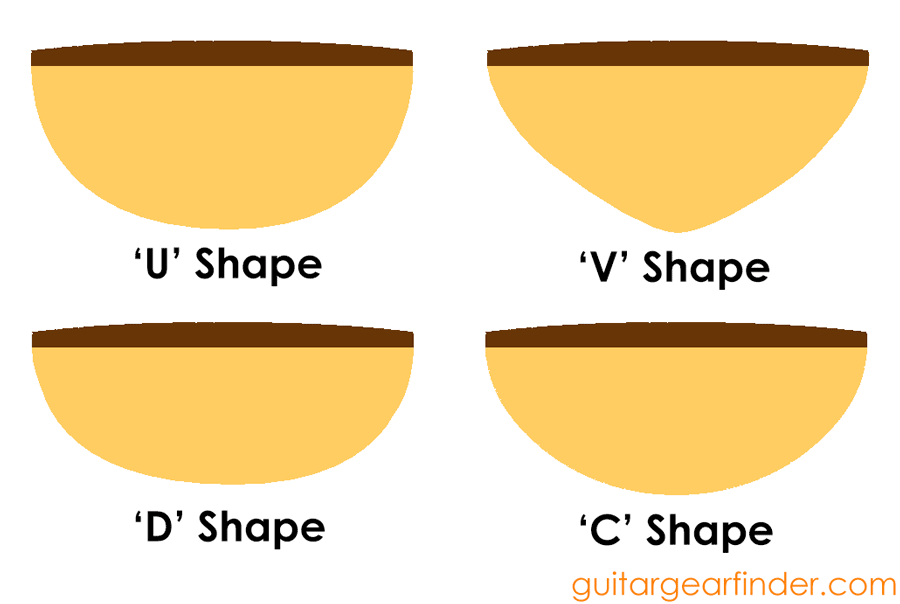To me, the neck is the most important thing about a guitar. It’s the part that’s always in your hand and governs how a guitar feels to play. A neck that is warped or bent will make a guitar unusable.
Neck shapes
In the early days of guitar building, the necks where shaped by hand from the raw neck blank. This must have lead to different neck shapes depending on who did the shaping etc.. So I would be careful about generalizations like “all ’57 Strats have V necks”, and “all ’58 Les Pauls have very fat necks”. Today though, mass-produced guitars have their necks shaped by CNC mills, with manual intervention limited to a final sanding step. Hence, neck shapes are much more consistent, and manufacturers explicitly state the neck shape and in many cases also the neck thickness at specific frets.

There are four main neck shapes:
- C: The most popular, a mostly continuous curve.
- U: Steeper sides than a C, though could be advertised as “thick C” as well.
- D: Flatter back than a C, and might overall be thinner than a C that has a similar curve to the side.
- V: Smaller radius at the center, often associated with ’50s Stratocasters.
Compound shapes are available, too. Some Fender V-shape necks have the V quite pronounced at the lower frets, which then feathers out into a more conventional C shape towards the higher frets.
Neck thickness
Guitar necks come in various thicknesses, and thickness is usually not constant along the entire neck. Hence manufacturers usually state (if they do) neck thickness at the 1st and 12th fret. Thinner necks are often associated with faster playing styles and hence more prevalent on “Metal” or “Shredder” guitars, while more traditional guitars often have somewhat thicker necks. On the thin end of the spectrum is the Ibanez Wizard III neck with 17mm at the 1st fret and 19mm at the 12th fret. Some of the fattest necks are probably found on some Telecasters and ’58-style Les Pauls, with thicknesses in excess of 25mm.
Which neck is best for you?
There is no simple, single answer to this. It depends at least upon:
- Personal preference
- Hand size
- Playing style
- Style of music you play
To illustrate this, I’ve got relatively small hands (glove size 8) with short fingers. My three guitars have quite different neck thicknesses. My Standard Strat has a “modern C” neck, my American Original ’60s Strat a fatter C, and my Les Paul Standard ’50s an even fatter C. Despite my short fingers, I find the Les Paul the most comfortable for play styles where the neck rests in the hand, such as open chords. I always found the modern C on the thin side for that. And while I found the AO ’60s neck quite fat when I first played it and wondered whether I could get used to it, it’s now normal to me.
On the other hand, when playing higher up the neck with stretched fingers and only the thumb on the neck, a fatter neck limits my range and feel uncomfortable. Here the thinner C shape of the Standard Strat feels better. This is evident in most guitars on the market – acoustics for chording have thicker necks, guitars for fast, technical play styles have thin necks.
Hence my recommendation is to try many different neck shapes and see what works best for you. You might be surprised to notice that a V neck feels really comfortable when playing chords, or that a thin C makes it much easier to shred up high. In the end, the conclusion will probably be that there’s always a reason for one more guitar. 😉
Fret size and fretboard radius
I have focused on the neck shape, but fret size and fretboard radius are a factor, too- though correlated with play style and neck thickness. Guitars designed for more traditional play styles and chording usually have lower frets and smaller (rounder) fretboard radii (down to 7.25″). Those for more modern styles often have taller frets (which makes legato play easier, but makes it more difficult to keep chords in tune) and flatter fretboard radii, usually in the 12″ to 16″ range.